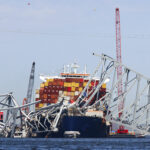A new study suggests certain earthquake fault segments long thought to be stable may rupture and cause a mega-quake.
That’s what happened during the 2011 magnitude-9 quake in Japan that triggered a tsunami and during the 1999 magnitude-7.6 Chi-Chi quake in Taiwan.
In both cases, scientists assumed that “creeping” segments in a fault would serve as a buffer and prevent the entire fault from unzipping.
But a new study published in the journal Nature suggests this may not always be the case.
This may have important implications for California’s San Andreas Fault, which has a creeping section that separates the locked segments in Northern and Southern California.
Copyright 2025 Associated Press. All rights reserved. This material may not be published, broadcast, rewritten or redistributed.
Was this article valuable?
Here are more articles you may enjoy.


 Estimate to Rebuild Baltimore’s Key Bridge Doubles to $5 Billion
Estimate to Rebuild Baltimore’s Key Bridge Doubles to $5 Billion  No Firm Is Immune if AI Bubble Bursts, Google CEO Tells BBC
No Firm Is Immune if AI Bubble Bursts, Google CEO Tells BBC  FEMA Chief Resigns After Six Months, Criticism Over Floods
FEMA Chief Resigns After Six Months, Criticism Over Floods  Kentucky Scrapyard Workers Describe UPS Plane Crash That Destroyed Their Business
Kentucky Scrapyard Workers Describe UPS Plane Crash That Destroyed Their Business 


